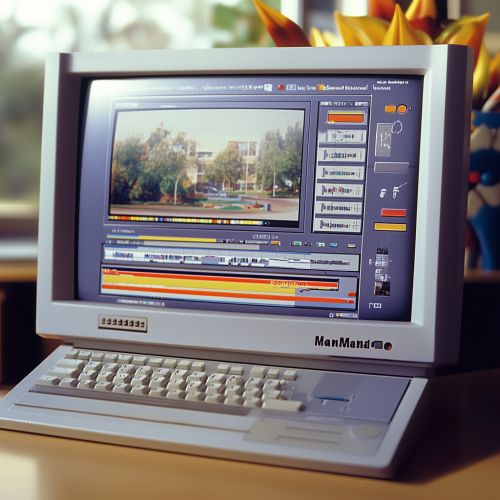Macromedia: Difference between revisions
(Created page with "== History of Macromedia == Macromedia was a prominent American software company that played a pivotal role in the development of multimedia, web development, and internet software in the late 20th and early 21st centuries. Founded in 1992 through the merger of Authorware Inc. and MacroMind-Paracomp, Macromedia became a leader in the creation of software tools for multimedia and web content creation. The company was headquartered in San Francisco, California, and was kn...") |
No edit summary |
||
| Line 17: | Line 17: | ||
Perhaps the most iconic product from Macromedia, [[Adobe Flash|Macromedia Flash]] revolutionized web animation and interactivity. Originally developed as FutureSplash Animator, Flash was acquired by Macromedia in 1996. It allowed developers to create vector-based animations and interactive content that could be embedded in web pages. Flash became ubiquitous on the internet, enabling rich media experiences and interactive websites. Its scripting language, ActionScript, further expanded its capabilities, allowing for the development of complex web applications. | Perhaps the most iconic product from Macromedia, [[Adobe Flash|Macromedia Flash]] revolutionized web animation and interactivity. Originally developed as FutureSplash Animator, Flash was acquired by Macromedia in 1996. It allowed developers to create vector-based animations and interactive content that could be embedded in web pages. Flash became ubiquitous on the internet, enabling rich media experiences and interactive websites. Its scripting language, ActionScript, further expanded its capabilities, allowing for the development of complex web applications. | ||
[[Image:Detail-98383.jpg|thumb|center|A computer screen displaying an early version of Macromedia Flash software interface, with vector graphics and animation timeline visible.|class=only_on_mobile]] | |||
[[Image:Detail-98384.jpg|thumb|center|A computer screen displaying an early version of Macromedia Flash software interface, with vector graphics and animation timeline visible.|class=only_on_desktop]] | |||
=== Macromedia Dreamweaver === | === Macromedia Dreamweaver === | ||
Latest revision as of 10:33, 11 October 2024
History of Macromedia
Macromedia was a prominent American software company that played a pivotal role in the development of multimedia, web development, and internet software in the late 20th and early 21st centuries. Founded in 1992 through the merger of Authorware Inc. and MacroMind-Paracomp, Macromedia became a leader in the creation of software tools for multimedia and web content creation. The company was headquartered in San Francisco, California, and was known for its innovative products that significantly influenced the digital media landscape.
The merger that formed Macromedia was a strategic move to consolidate expertise in multimedia authoring and animation. Authorware Inc., founded by Michael Allen, specialized in educational software, while MacroMind-Paracomp, led by Marc Canter, was known for its animation and graphics software. This combination allowed Macromedia to leverage the strengths of both companies, leading to the development of groundbreaking products.
Key Products and Innovations
Macromedia's product line included several influential software applications that became industry standards in multimedia and web development. Among its most notable products were:
Macromedia Director
Macromedia Director was a multimedia application authoring platform that enabled the creation of interactive content. It was widely used for developing CD-ROMs, kiosks, and early web content. Director's scripting language, Lingo, provided powerful capabilities for developers to create complex interactive applications. The software was instrumental in the rise of multimedia content in the 1990s.
Macromedia Flash
Perhaps the most iconic product from Macromedia, Macromedia Flash revolutionized web animation and interactivity. Originally developed as FutureSplash Animator, Flash was acquired by Macromedia in 1996. It allowed developers to create vector-based animations and interactive content that could be embedded in web pages. Flash became ubiquitous on the internet, enabling rich media experiences and interactive websites. Its scripting language, ActionScript, further expanded its capabilities, allowing for the development of complex web applications.


Macromedia Dreamweaver
Macromedia Dreamweaver was a web development tool that provided a visual interface for designing and coding websites. It supported a wide range of web technologies, including HTML, CSS, JavaScript, and server-side scripting languages. Dreamweaver's intuitive design environment and robust code editor made it a popular choice among web developers and designers.
Macromedia Fireworks
Macromedia Fireworks was a bitmap and vector graphics editor tailored for web designers. It offered tools for creating and optimizing web graphics, including image slicing, rollover effects, and image compression. Fireworks integrated seamlessly with other Macromedia products, enhancing the workflow for web development projects.
Macromedia FreeHand
Macromedia FreeHand was a vector graphics editor used for creating illustrations and layouts. It was particularly popular among graphic designers and illustrators for its precision and versatility. FreeHand supported multiple pages and layers, making it suitable for complex design projects.
Impact on Web Development and Multimedia
Macromedia's products had a profound impact on the evolution of web development and multimedia content creation. The company's tools empowered developers and designers to push the boundaries of what was possible on the web, leading to more engaging and interactive user experiences. Flash, in particular, became a cornerstone of web animation and interactive content, shaping the way websites were designed and experienced.
The widespread adoption of Macromedia's software also contributed to the standardization of web technologies. As developers embraced tools like Dreamweaver and Flash, they helped establish best practices and conventions in web design and development. This, in turn, influenced the development of web standards and technologies that continue to shape the internet today.
Acquisition by Adobe Systems
In 2005, Macromedia was acquired by Adobe Systems for approximately $3.4 billion. The acquisition was a strategic move by Adobe to expand its portfolio of creative software and strengthen its position in the digital media market. The integration of Macromedia's products into Adobe's suite of software tools allowed for greater synergy and innovation in the development of multimedia and web applications.
Following the acquisition, many of Macromedia's products were rebranded under the Adobe name. Flash, Dreamweaver, and Fireworks continued to evolve as part of Adobe's Creative Suite, benefiting from Adobe's resources and expertise. However, the acquisition also marked the beginning of the end for some Macromedia products, as Adobe streamlined its offerings and focused on integrating features across its software lineup.
Legacy and Influence
Macromedia's legacy is evident in the lasting impact of its products and innovations on the digital media industry. The company's pioneering work in multimedia and web development laid the foundation for many of the tools and technologies used by developers and designers today. Macromedia's emphasis on interactivity and user experience helped shape the evolution of the internet, making it a more dynamic and engaging platform.
While some of Macromedia's products have been phased out or replaced by newer technologies, their influence can still be seen in modern web development practices and multimedia content creation. The company's commitment to innovation and creativity continues to inspire developers and designers around the world.
